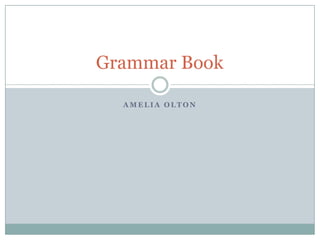
Grammar book for spanish
- 1. Grammar Book AMELIA OLTON
- 2. Table of Contents 1.Nationalities 2.Stem Changers 3.Para 4.Indirect Object Pronouns 5. Pronoun Placement 6.Gustar 7. Affirmative and Negative 8. Superlatives 9. Reflexives 10. Affirmative tu commands/ irregular/ pronoun placement 11. Negative tu command/irregular/pronoun placement 12.Sequencing events
- 4. Jugar U>UE Juego Jugamos Juegas Jugaís Juega Juegan Pensar E>IE Pienso Pensamos Piensas Pensaís Piensa Piensan Pedir e>I Pido Pedamos Dormir O>UE Pides Pedaís Duermo Dormimos Pide Pieden Duermes Dormaís Duerme Duerman
- 5. Para Common uses of Para: Para is often confused with Por which is a rarely interchanged word for for. Where Para is used: To mean "in order to": When used in this way, it is followed by an infinitive. To indicate purpose or need With estar to mean : “to be ready to” To mean "no later than" or "by”
- 6. Indirect Object Pronouns Me Nos Te Os Le Les Indirect Object Placement 1. Before the conjugated verb 2.Attached to an infinitive 3.Attached to a gerund *The Pronouns Le and Les sometimes refer to different indirect objects. To clarify the difference, they are accompanied by a noun, name, or pronoun . Example:Mi madre te compró un libro. (My mother bought you a book.)
- 7. Pronoun Placement 1.Attach the pronoun to the infinitive 2. Attach the pronoun to a progressive tense 3. Attach the pronoun to an affirmative command. 4. Place the pronoun before a conjugated verb.
- 8. Gustar Singular Me (Gusta) Nos (Gusta) Te (Gusta) Os (Gusta) Le(Gusta) Les (Gusta) -Even if attached to more than one infinitive, it will remain singular. You often need to read the sentence backwards: Me gusta el gato. The cat is liked by me. *The form of gustar matches the noun, not the speaker. Plural Me (Gustas) Nos (Gustas) Te (Gustas) Os (Gustas) Le (Gustas) Les (Gustas)
- 9. Affirmatives and Negatives Algo – something Nada-Nothing Nadie- No one Alguien -Someone *Ningun/ Ninguno- None, *Algún/Alguno -some Not any Nunca- Never Siempre -always Tampoco- Neither, either También- tampoco Ningun must also match the *Alguno must match gender of the noun they replace or modify. the gender of the noun they replace or modify. A double negative is required in spanish when no preceeds the verb, except if the negative word comes before a verb, a second verb is not needed.
- 10. Superlatives Isímo Isímos/Isímos Isímas Added to adjectives and adverbs, Equivalent to extremely or very and is placed before an Adjective or verb . An adjective that is ending in –n or –r are formed by adding cisímo Adjectives that end in C,G or Z change spelling to que, gu, and c. -Feliz- Felizcisimo
- 11. Reflexives Reflexive verbs are something that one does to themselves such as Position of reflexives : brushing ones teeth or hair. Ex: Pepa se lava el pelo. 1.. In front of conjugated verb 2. Attached to infinitive - Pepa washes her hair 3. Attached to Gerund - Ex: Me levantó 4. Attached to infinitive command. - I wash my self - Reflexive pronouns are used with or without reflexive verbs. When there is no reflexive pronoun, the person doing the act
- 12. Affirmative tú commands/irregulars/pronoun placement Affirmative Commands Give instructions or commands to someone by using Affirmative tu commands of regular verbs Caminar/ Camina/ ¡Camina en el parque! Placement :When using an object pronoun, attach the pronoun to the end of the command Cruza el parque > ¡Cruzalo! Infinitive Tu command Decir Di Irregular Commands Hacer haz Primero haz los quehaceres Ir Ve First do the chores Poner Pon Salir Sal Tener Ten Venir Ven
- 13. Negative tú commands/ irregular/ pronoun placement Formed by: Taking you form of the present tense, dropping the o and adding the appropriate ending. Infinitive Yo form Negative tu command Hablar Hablo No Hables! Volver Vuelvo No vuelves Venir Irregular (Yo Form) Placement: Infinitive: Dar (doy) Command: No le des mi direccion a nadie - Dont give my adress to anyone. Pronouns precede the verb in negative commands Infinitive: Estar Command: No estés triste -don’t be sad
- 14. How to form Tú commands 1. Affirmatives : Drop the –s 2. Put in Yo form, cange vowel, add-s 3. Affirmative irregulars: Di , Haz, Ven, Pon, Sal, Se, Ten, Ven Irregular Commands: Tener No Tengas Venir No Vengas Dar/ Decir No des/ digas Ir No vayas Ser No seas Hacer No Hagas Saber/ Salir No sepas/ salgas
- 15. Sequencing events Used to show what events are in what specific order. Primero- First Entonces- after luego/después-/ Por Fin then/after / Finally Antes de/ después de- before that/ after that Por la mañana/ tarde/ Noche- In/ during the-( no specific time given) Los lunes etc.- on Monday, or any other day